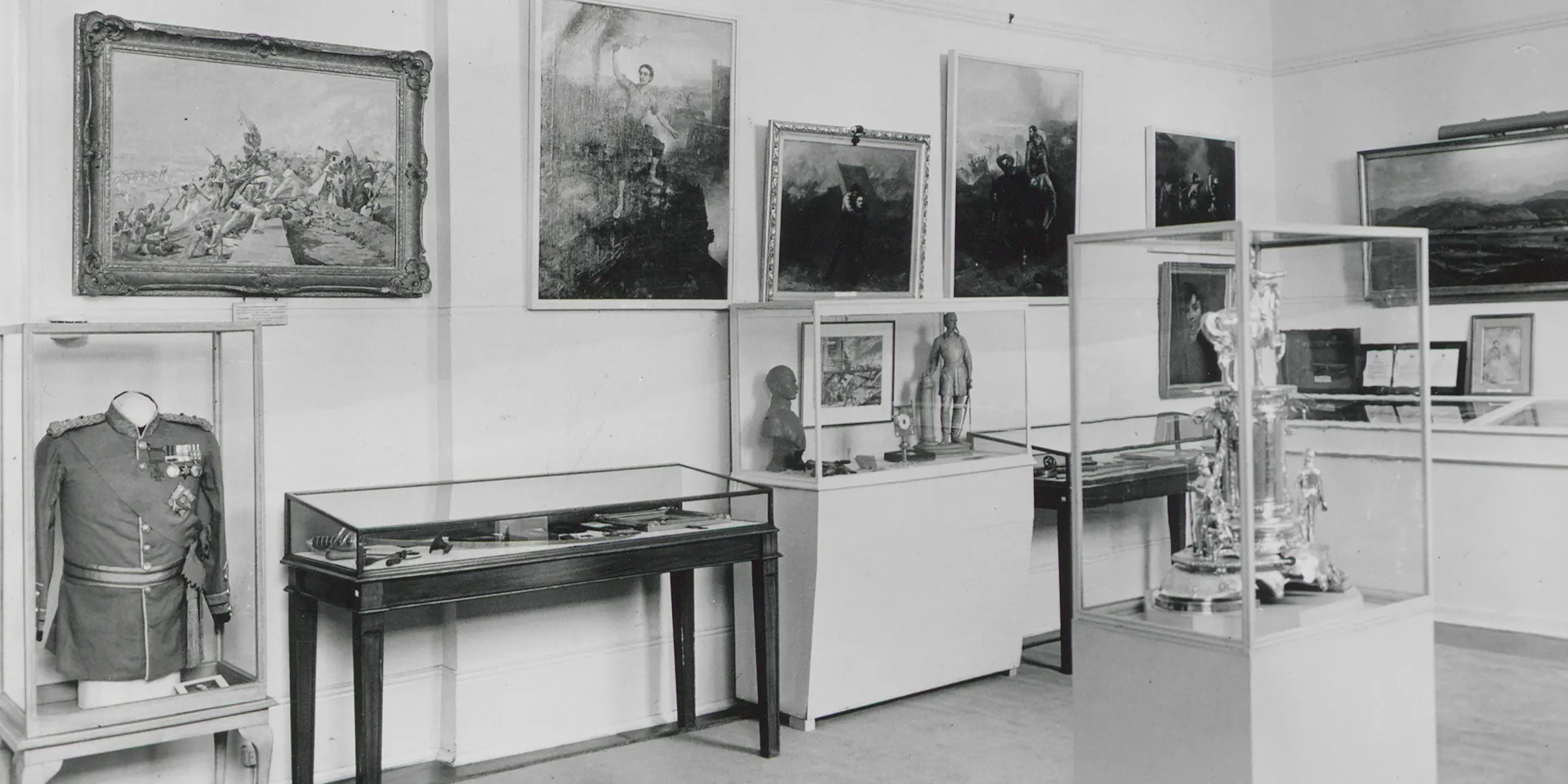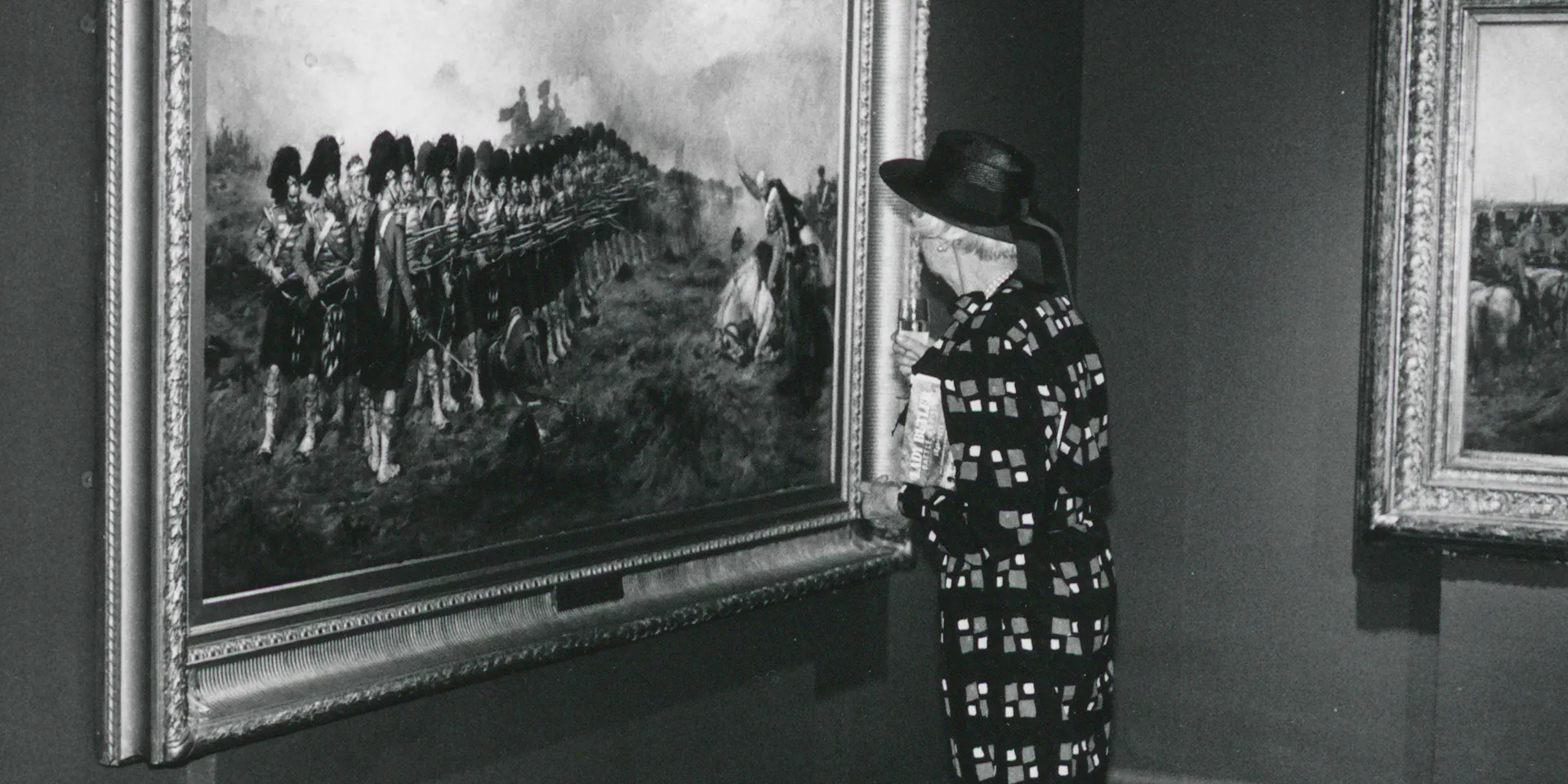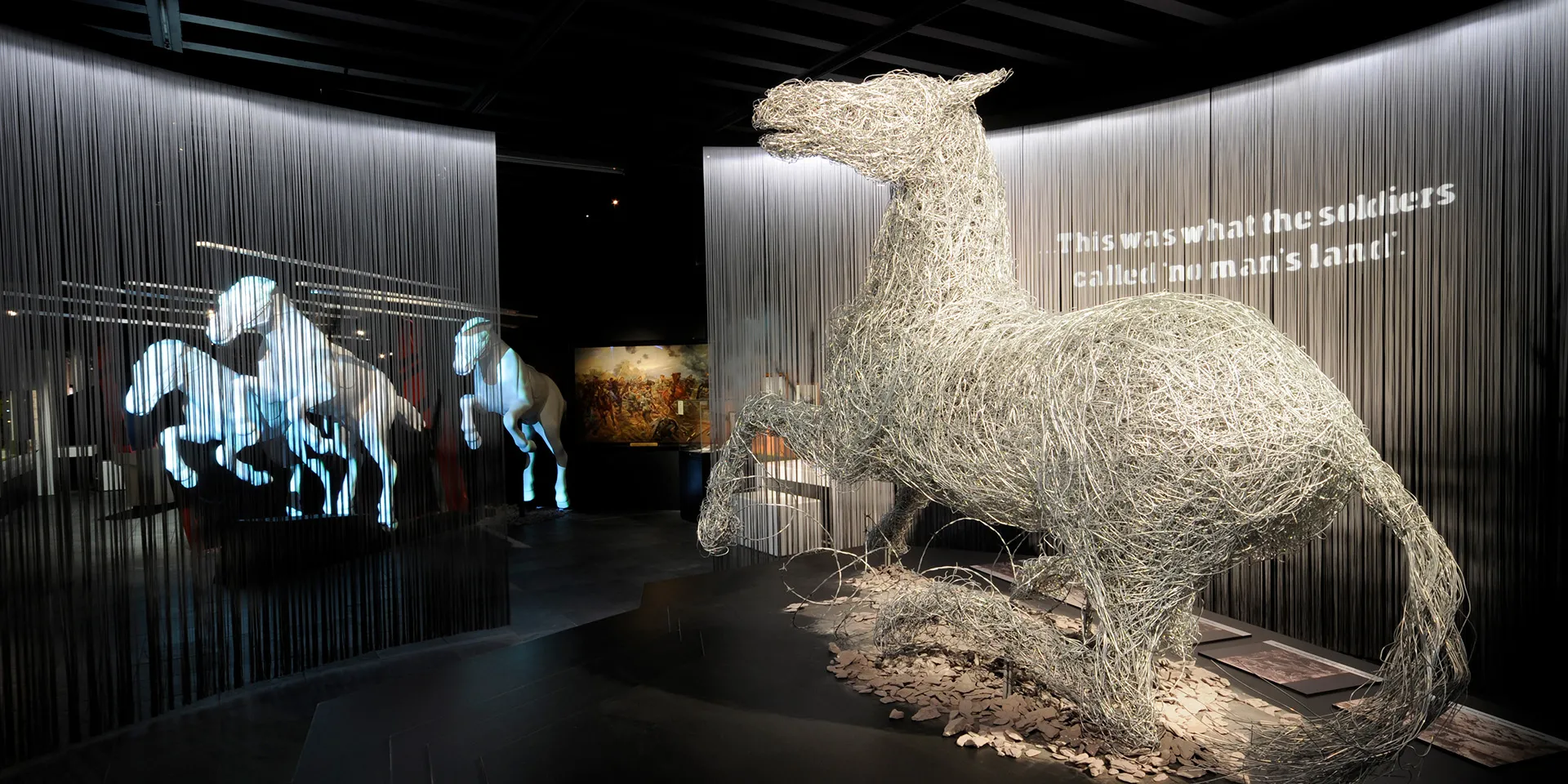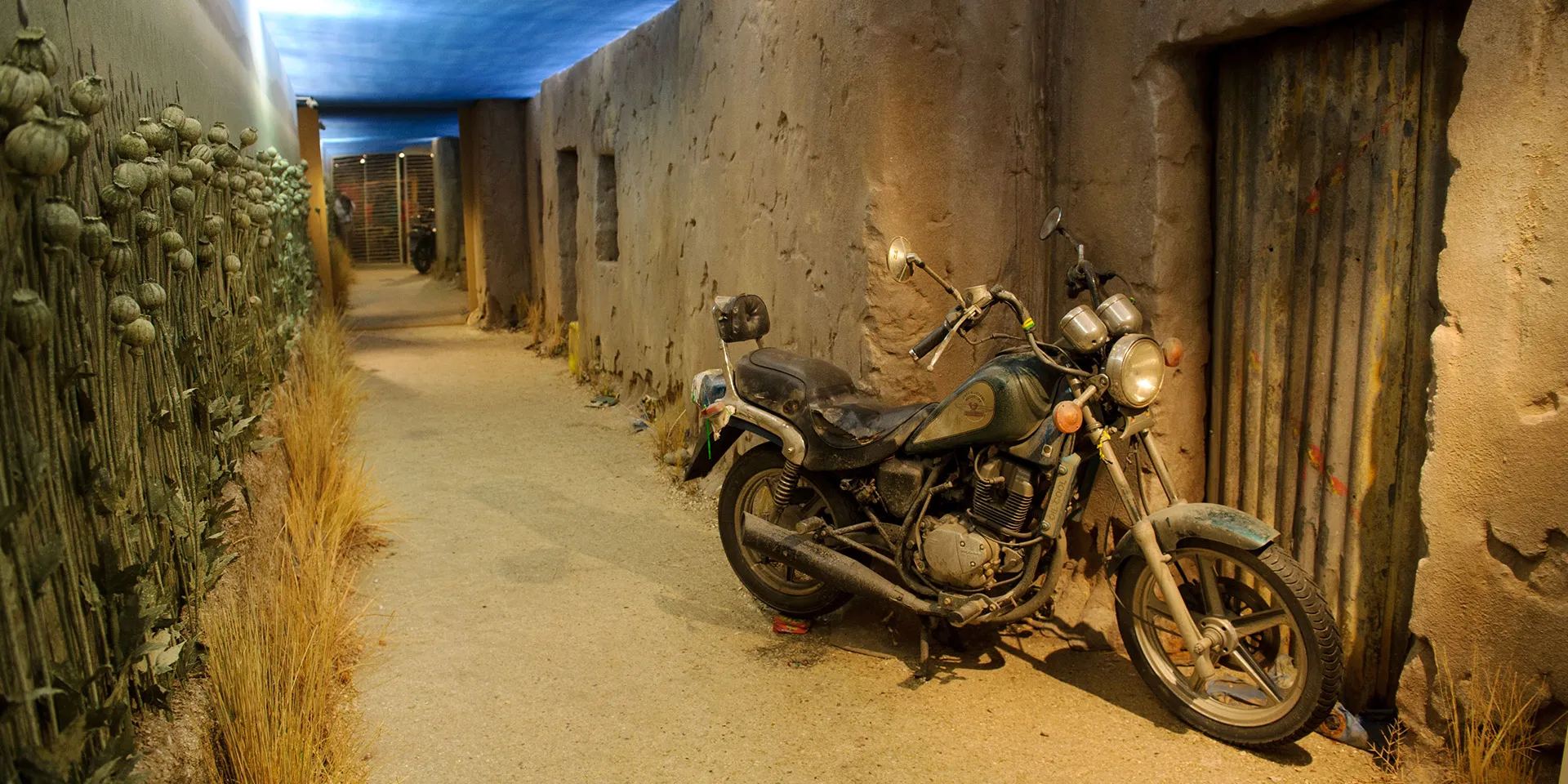
Victoria Crosses and George Crosses exhibition, 1962
1962
The Victoria Crosses and George Crosses of the Honourable East India Company and Indian Army
The National Army Museum held its first special exhibition in the Hastings Room at the Royal Military Academy Sandhurst. Opened by the Museum’s first patron, the Duke of Gloucester, it centred around gallantry awards presented to Indian Army soldiers between 1856 and 1945.
Victoria Crosses and George Crosses were displayed alongside paintings, photographs and other related items. A specially commissioned memorial book was also included. Most of the medal groups were on loan from the families of the recipients and were returned soon after the exhibition ended.

Visitors at the London's Citizen Soldiers exhibition, 1972

A Pikeman and Musketeer of the Honourable Artillery Company, 1972
1972
London's Citizen Soldiers
Following the Museum’s move to purpose-built premises in Chelsea, it wasn’t difficult to find partners willing to supplement the new permanent galleries with special, temporary displays. Discussions with the Territorial and Auxiliary Forces Association resulted in an exhibition of items relating to the service of territorial forces in London throughout the ages.
Relocating the Museum from Sandhurst to Chelsea had been motivated in part by a desire to increase public access and engagement. During this exhibition, historical re-enactors and armoured vehicles were deployed on the Museum forecourt to invite the attention of potential visitors.

The Duke of Kent visiting the Tiger of Malaya exhibition, 1981
1981
The Tiger of Malaya
This exhibition was a tribute to Field Marshal Sir Gerald Templer (1898-1979). As well as enjoying a long and distinguished Army career - which included a vital period of command during the Malayan Emergency (1948-60) - Templer played a major part in the development of the National Army Museum following his retirement from the role of Chief of the Imperial General Staff in 1958.
The exhibition had input from members of his family and others who knew him, and featured many items donated to the Museum by Templer himself. It also coincided with the publication of a biography.

Lady Butler, Battle Artist exhibition, 1987
1987
Lady Butler, Battle Artist
This was the first large-scale survey of Lady Elizabeth Butler's career. The exhibition explored the French artists who influenced her, as well as the enormous influence she had on future generations of war artists.
Alongside paintings borrowed from national collections across the country, it included works which had never been shown in public before, some of them from private collections including that of the Butler family.
Arguably the Museum's first blockbuster, it was also the first of the Museum's exhibitions to go on tour after closing in London. The accompanying catalogue won the prize for best museum publication of the year.

Rex Whistler's War exhibition, 1994
1994
Rex Whistler's War
The Museum held an exhibition of the work of the artist and illustrator Rex Whistler to mark the 50th anniversary of his death in Normandy. 'The Times' newspaper received more letters about Whistler's death than for any other casualty of the Second World War.
The exhibition brought together Whistler’s wartime paintings, sketches, set designs, book jackets, murals, illustrated letters and photographs. One of the highlights was a recently acquired self-portrait, in which Whistler depicted himself in his brand new Welsh Guards uniform.

Exhibition leaflet (cover), Soldiers of the Raj, 1997

Exhibition leaflet (centrefold), Soldiers of the Raj, 1997
1997
Soldiers of the Raj
Marking 50 years since the end of British rule in India, this exhibition told the story of the armies raised by Britain on the subcontinent from 1600 to 1947, and the people - men and women, Indian and British - who served in them.
This was an opportunity for the Museum to delve into the roots of its collection. A significant part of the Museum's earliest holdings comprised items deposited at Sandhurst by British officers who had returned home from service in the pre-partition Indian Army.
The exhibition was the largest and most comprehensive display of the Museum's Indian Army material, and included silverware, ceramics, uniforms and artworks.

Crimean War mannequins in the 2003 exhibition, A Most Desperate Undertaking
2003
A Most Desperate Undertaking
This exhibition explored Britain's involvement in the Crimean War (1854-56), marking the 150th anniversary of the outbreak of the conflict.
In recent years, the Museum's approach to exhibitions had been fairly traditional. Displays had been geared primarily towards an academic audience, with long captions and panel text. And each exhibition was accompanied by the publication of a detailed catalogue.
With this exhibition, efforts were made to appeal to audiences with a more general interest in the subject matter. And there was a greater degree of interactivity to the displays.
To coincide with the exhibition, the Museum worked with the History Channel to produce a television documentary, narrated by the actor Robert Hardy.

Army quad bike and trailer, Helmand exhibition, 2007

Reconstruction of sleeping quarters, Helmand exhibition, 2007
2007
Helmand
For this exhibition, the Museum took a very different approach, drawing on contemporary Army links to bring to the public items of much more recent provenance.
It was devised and created in collaboration with 16 Air Assault Brigade, primarily to raise awareness of the formation’s activities and sacrifices in Afghanistan – a conflict which remained ongoing at the time. However, it also served to reconnect the Museum with the modern-day Army.
This was the Museum’s first time working with external design company MET Studio. The exhibition featured a wealth of digital material including photographs and video taken by the soldiers on operation, delivered via innovative interactives embedded within the displays.
Feedback collected from visitors reflected a wide range of views and opinions on the war in Afghanistan, demonstrating that the Museum was reaching and engaging new audiences. Similar displays at both the Imperial War Museum and the Tank Museum followed.

Wire horse sculpture, War Horse, 2011
2011
War Horse
In 2007, Sir Michael Morpurgo’s First World War-themed novel 'War Horse' was adapted into a successful stage production at the National Theatre. A film version directed by Steven Spielberg followed in 2011. The Museum identified an opportunity to attract a more diverse audience with an exhibition looking at the facts and fiction behind this cultural phenomenon.
Again developed with MET Studio - along with partners in the media and arts, and Morpurgo himself - the exhibition balanced opportunities to reflect on the often sombre subject matter with elements of fun for younger visitors.
Stunning set works, as well as loans from stage and screen, accompanied the collections on display. Promotional activities surrounding the exhibition included the decoration of paper horses, with some designs sent in by well-known names.

Paper war horse decorated by Alan Titchmarsh

Paper war horse decorated by Michael Foreman
2013
Unseen Enemy
Unseen Enemy was the last exhibition to be held at the Museum before it closed its doors for a major redevelopment in 2014. Again, the exhibition drew on very recent acquisitions - guided by a new contemporary collecting policy - this time to show the impact of improvised explosive devices (IEDs) on soldiers and their families.
Extensive use of oral history recordings provided first-hand insights into all aspects of dealing with IEDs: search and disposal, injury and recovery, and coping with the loss of friends and loved ones. The exhibition also featured an immersive corridor, recreating the challenge of detecting a hidden device in an Afghan compound.

Immersive corridor, Unseen Enemy, 2013
Institutional Archive
This story is illustrated with images from the National Army Museum's Institutional Archive. To mark our 60th anniversary, we are making the catalogue of this archive available to researchers online for the first time.
The catalogue provides information about records created by the Museum since its founding in 1960, including its early existence at the Royal Military Academy Sandhurst. It covers a range of categories, from governance to collection records, events to building records, as well as photographs and posters.
We will be publishing further catalogue records over time, establishing what we hope will prove a useful resource for researchers of museology and military history.




